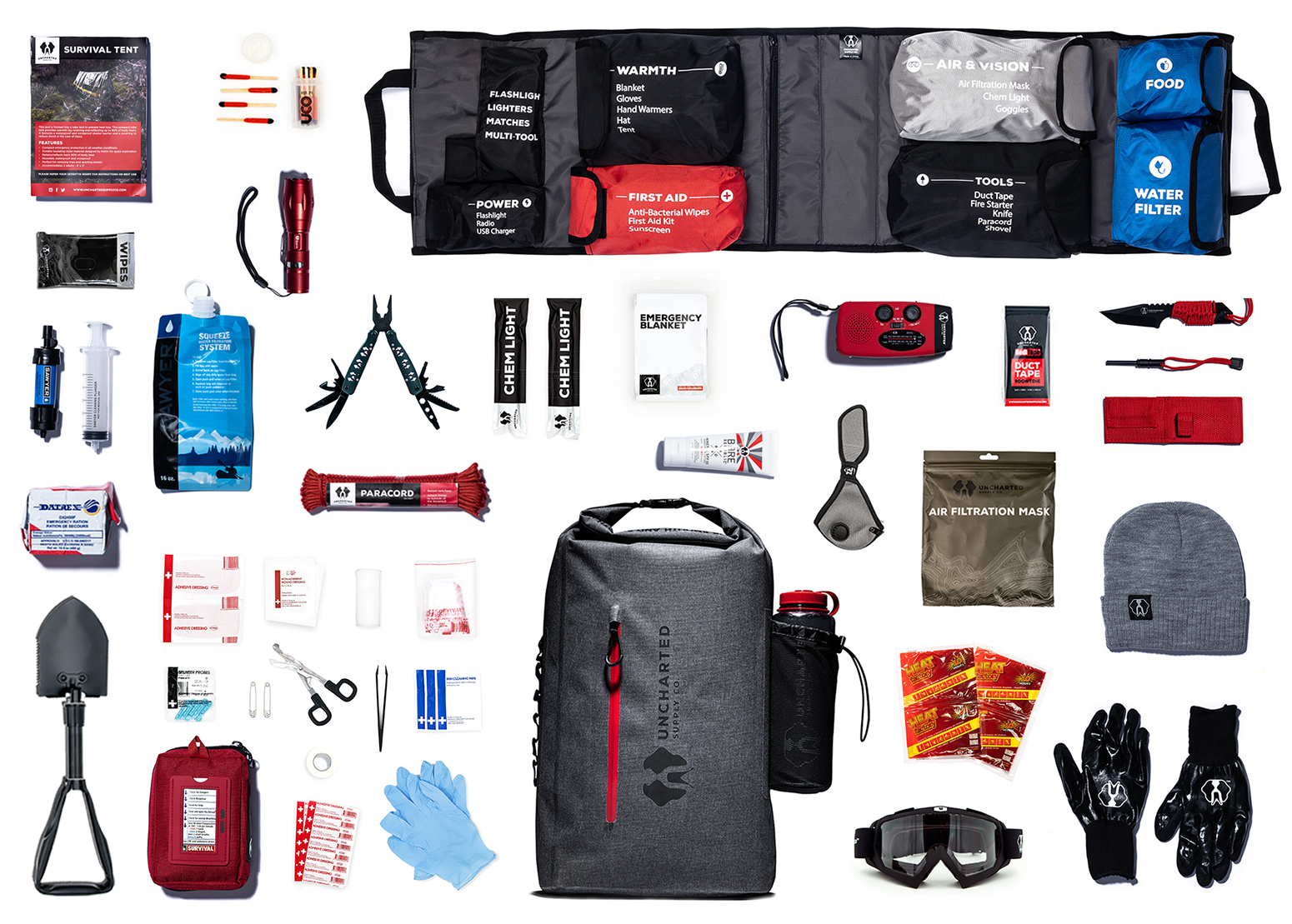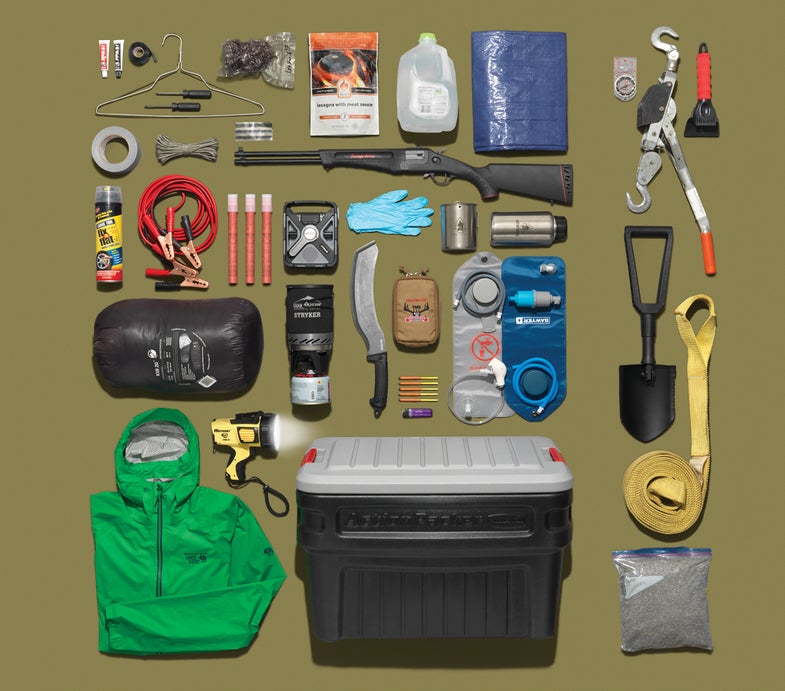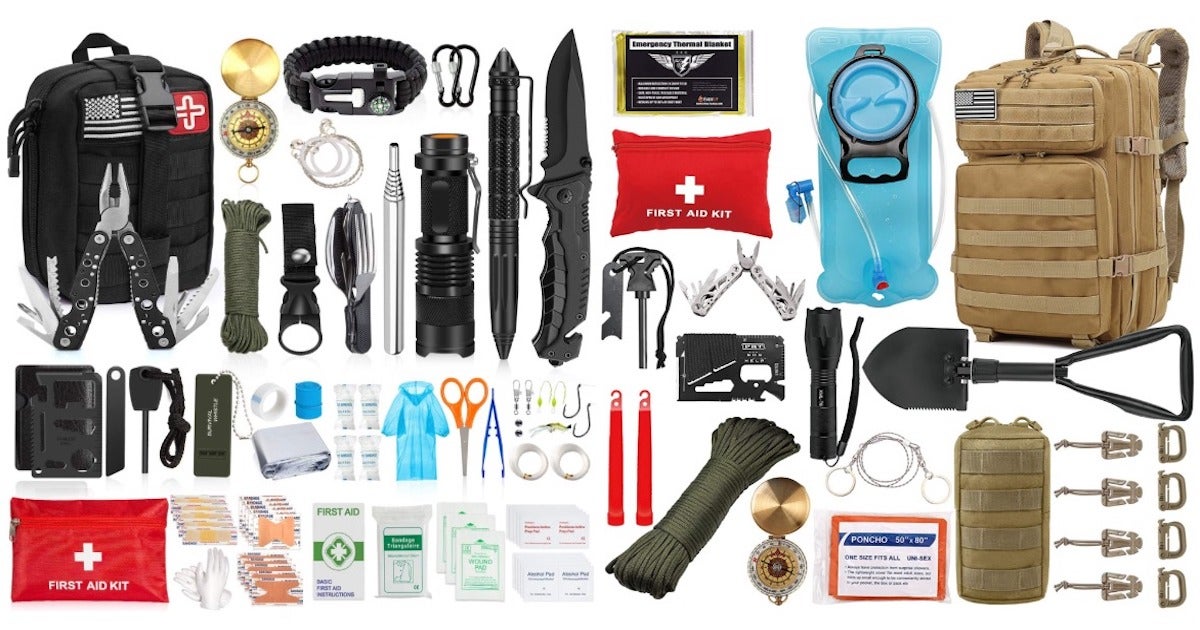It’s always important to be prepared for anything, and having a survival bag is an essential part of that preparedness. A survival bag is a bag that contains items you may need to survive in a variety of different scenarios. Whether you’re out in the wild or caught in a natural disaster, having a survival bag can help you get the supplies you need to stay safe and alive. While the items you should pack in your survival bag depend on the specific situation you’re in, there are some basic items you’ll want to include in any survival bag.
The first item to include in your survival bag is some kind of water containers like a canteen, water bottle, or hydration pack. Water is essential to survival, so make sure you have a way to carry and store it. You should also include a water filter or purification tablets to make sure the water you find is safe to drink.
Food is another necessity and should be included in your survival bag. Pack as much non-perishable food as you can, like energy bars, nuts, and dried fruit. If you’re going to be in a survival situation for an extended period of time, you may also want to include a camping stove and fuel to cook meals.
A basic first aid kit is also important. Make sure you include things like bandages, gauze, antiseptic wipes, and other items you may need to treat minor injuries. If you want to be extra prepared, you can also include medical supplies like sutures, splints, and tourniquets.
A flashlight, whistle, and other signaling devices are also essential items to bring with you. You’ll want to be able to signal for help if you get lost or injured. A knife is also important for helping you build shelter and make tools, so make sure to pack one. And don’t forget a map and compass to help you get where you’re going.
Finally, you should also pack some kind of shelter item, like a camping tent, tarp, or sleeping bag. Having the right shelter can make the difference between life and death in the wilderness.
By including the items mentioned above, you can ensure that you’re prepared for any survival situation. With a survival bag, you’ll have the supplies you need to stay safe and get back home.

Essential bug-out bag checklist
When faced with an emergency, having the right items in your bug-out bag can make all the difference. A bug-out bag, or “go bag”, is a pre-assembled collection of essential items that you can grab and go in a hurry if you ever find yourself in an emergency situation.
Building an effective bug-out bag is critical for anyone who wants to be prepared for any situation. Here is an essential bug-out bag checklist to get you started:
Shelter: Having a shelter is essential for protection from the elements. Your shelter should be lightweight and easy to carry. A tarp, tent, or hammock is a great option. In addition, a sleeping bag, blanket, and pillow can provide warmth and comfort in the wilderness.
Clothing: In an emergency, you will want to stay as dry, warm, and comfortable as possible. Pack a few changes of clothing that are lightweight and durable. You should also include items like a raincoat, hat, and gloves.
Food and Water: In an emergency, you may not have access to clean food and water. Pack enough non-perishable food to last a few days, and consider packing a water filter or water purification tablets to make sure your water sources are clean and safe.
Tools and Supplies: Having the right tools and supplies can make a huge difference in an emergency. Pack items such as a knife, flashlight, compass, fire starter, and cordage for making shelter. You should also include items such as a multi-tool, whistle, and a first aid kit.
Personal Items: Don’t forget to include items such as a map, notebook, pen, and an extra pair of eyeglasses. Other items such as a book or a small game can provide entertainment and help keep morale up.
There you have it – a basic bug-out bag checklist. While this list is a great start, it is important to customize your bug-out bag to fit your own needs. Once you have the essential items, you can add any additional items that you feel you may need.
By having the right items in your bag, you can be prepared for any emergency situation. Don’t wait until it is too late, start building your bug-out bag today.
What should you put in a survival kit?

When it comes to survival, having the right items in your survival kit is essential. A survival kit is a collection of items that you would need in order to survive in an emergency situation. The items you put in your survival kit will depend on the environment you are in and the type of survival situation you may face.
The most important element of your survival kit should be the items you need to stay alive. This would include water, food, and other items to sustain life. You should also include items that can help you stay safe such as a first-aid kit, a flashlight, a knife, a compass, and a whistle. You may also want to consider including a shelter, such as a tarp, a sleeping bag, and a tent.
In addition to these items, you should also include items to help you navigate the environment. This would include a map, a GPS device, and the ability to make a fire. You should also include items to help you signal for help or make noise. This could be a mirror, a fire starter, and a radio.
If you are planning to stay in a certain area for an extended period of time, you may want to include items to help you stay comfortable. This could include items such as a multi-tool, a sewing kit, a water filter, and a fire starter. It is important to know what items you may need in your survival kit before you need them.
It is also important to remember that the items you put in your survival kit should be lightweight and durable. You should avoid items that are bulky or hard to carry. You should also prioritize items based on their necessity. You should focus on items that will help you stay alive and safe, and then add items that will help you stay comfortable and organized.
Your survival kit should be tailored to the environment you are in and the type of survival situation you may face. However, having the right items in your survival kit is essential for staying alive and safe in an emergency situation. Be sure to include the items you need to stay alive, navigate the environment, and stay comfortable.
Survival Gear and Equipment: The Ultimate Bug-out bag items
When it comes to survival, you don’t want to be caught unprepared. Having the right survival gear and equipment can make the difference between life and death, so it’s important to invest in quality items that are suitable for a variety of environments. In this guide, we’ll take a look at the different types of survival gear and equipment that you should consider adding to your arsenal.
A first aid kit
Having a basic first aid kit is one of the most important things you can have before, during, and after an unexpected disaster.
First aid means treating any injury or illness immediately to prevent more serious health problems down the road. It’s good to know some basics about first aid so that if something happens you are as prepared as possible.
Many people start with a standard first aid kit which doesn’t include much beyond bandages and alcohol swabs. These are all very useful pieces of equipment but they aren’t enough!
You should always add extra items to your first aid kit depending on what situation you find yourself in. For example, someone could get hurt lifting a refrigerator off of them so having a pair of sturdy shoes is helpful.
Likewise, someone could trip and fall outside so a flashlight and a small notebook and pen are also great additions.
Sunscreen
While many people tell you to never go outside without sunscreen, this is not necessarily true! When it comes down to it, everyone has different sun protective strategies that work for them. Some like to layer on the protection while others cannot stand the feeling of too much coverage.
Luckily, there are now SPF ratings up to 150! An average person needs at least one good quality sun screen with an SPF of 30 or higher peruse. This will help protect your skin from sun damage as well as prevent burning.
You want to make sure your sunscreen contains both UVB (which helps keep your skin protected from overexposure) and UVA ( which aids in protecting your skin tone and preventing dryness) rays.
Bug spray
One of the most important things to have in your bug-out bag is some kind of insect repellent. There are many types of natural insect repellents that you can take with you at any time!
You can make your own homemade deet or cream-based sprays, tinctures, oils, and gels. Natural products usually contain ingredients like plants or essential oils that work as protective layers around your skin.
Some examples of natural bug sprays include herbal extracts such as citronella (which works by interfering with the chemical communication system in insects) and pepper oil (which actually irritates their nerves and makes them uncomfortable).
There are even liquids called DEET (diethyltoluene emulsion) which people mix into their hands and apply to their exposed areas to protect themselves from mosquitoes. However, there has been controversy over whether these chemicals are safe for long-term exposure.
So while they may be effective for short periods of use, we recommend using something more eco-friendly instead.
Flashlight
A very important piece of equipment to have in any sort of wilderness setting is a light source- this can be done in many ways!
Most people carry some form of flashlight these days with cell phones being one of the most common ones. These are great for having fun under the moon or reading at night, but they will not help you survive anything beyond that.
Good quality LED (Light Emitting Diode) torch-style flashlights are excellent for this purpose as they emit much brighter light than a normal candle-type bulb. They also don’t use too much power which is helpful as we now know how quickly things lose power in a situation.
Fire starter
A very important item to have in your emergency preparedness kit is a good fire-starting method. There are many ways to make sure you never need this tool, so it is worth the time to learn several types of starters.
Many people use paper as a fire start sheet but this can be difficult to find when needed. A better option is using a tinder, which does not contain much moisture. Some of the best tinders are dry grass, dried flowers or leaves, or shredded cardboard.
These items must be mixed with some kind of ignition source-usually a match, candle, or fluid (like gasoline) already available at home. When performing these practices, only add one type of fuel at a time and make sure each component takes less than five minutes to burn down completely.
After experimenting with various methods, I discovered my favorite is using white vinegar and steel wool as the combustion source and tinder, respectively. Both work well and don’t require any additional resources.
Compass
A compass is one of the most important items to have in any kind of wilderness setting. There are many ways to use a compass, but one of the easiest to understand is determining which direction is north. You can either hold it up and see if it points towards the North Pole or you can have it read a magnetic map for you.
Both work well, but some require more advanced skills to use correctly. Having a basic understanding of how to use a magnetically-readable compass will help you get through part of this!
Many people start off using a declinometer method where they look at their watch to determine time. While this works, there’s not much accuracy unless you have access to a clock that doesn’t need electricity to function.
Using a GPS is another way to find out what angle degrees north is. However, this isn’t always easy to have when you don’t have cell service or a smartphone with satellite navigation. It also costs extra money!
A simpler solution is to just learn how to use a normal compass. These do not need power and work anywhere there is metal. They simply align with the axis of the earth and show you what angle degree south is by how far away they are from vertical.
The Basics

When it comes to packing for an emergency, there are some items that everyone should have. These are typically referred to as a first aid kit, food storage, and a water purification system.
First aid kits contain important supplies such as bandages, pain relief medications, eye drops, and topical creams or gels to treat minor wounds and cuts. They also include whole-body warmers which can be used to preserve warmth when trying to restore heat loss during cold weather conditions.
Food storage is another item that almost every person needs to know how to use. This includes stocking up on foods that will not go bad, nor require special preparation. Some easy-to-make snacks that anyone can pick up immediately are dried fruits and vegetables like carrots or apples.
Lastly, we will talk about something that is becoming more popular than ever before – purified drinking water. There are many ways to drink water that have special additives to help eliminate bacteria or change the color of the liquid so that you cannot tell if it has broken down already.
These three things are essential for any survivor because they ensure immediate restoration of health should someone encounter serious injury or illness.
Emergency Food Supply
Having enough food for an emergency is one of the most important things you can have before, during, and after a crisis.
We all have different needs and timing will determine how much food we need to stock up on depending on what situation we are in.
But having at least a two-week supply of non-perishable foods is a great place to start. This includes foods that taste good, eat many (or all) of your nutritional vitamins and minerals, and are cost-effective or even free if prepared correctly.
Many people begin by stocking up on pasta, sugar, and bread, but these are not optimal snacks when you don’t have access to better eats!
Too often I see people buying canned goods with little flavor and no nutrition. These are totally fine additions to your collection, but make sure they are nutritious ones first.
I wouldn’t recommend investing in pre-packaged dried fruits and vegetables unless they say they get destroyed or wasted during storage. More expensive brands that say this include MREs (Meal Ready Meals), and there are some great alternatives you can make yourself as well.
